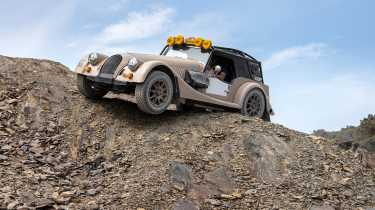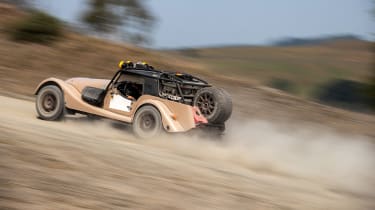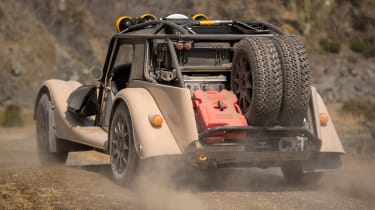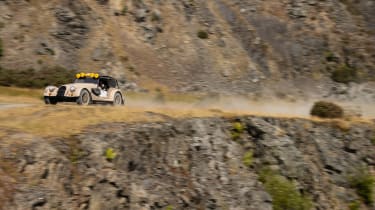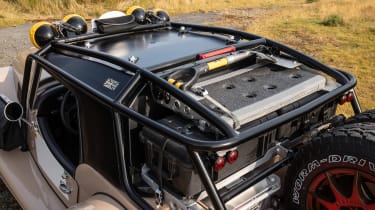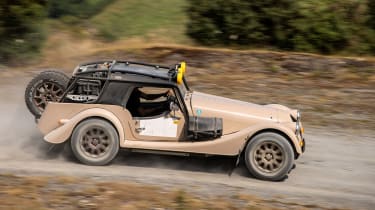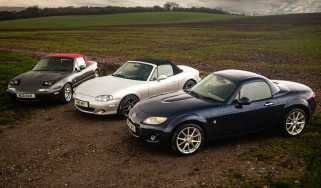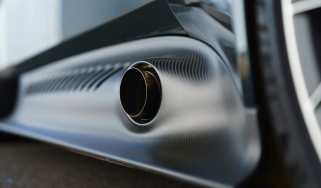Morgan Plus Four CX-T 2022 review – driving the best type of crossover
A crazy way to spend a lot of money, but great fun whilst doing so...
Have I entered a subtly alternate universe? A sort of steampunk wonderland, perhaps? For starters I’m in Wales and the sun is out, the grass bleached brown. Most unusual. Then there is the vehicle in front of me. Even the most fleeting of glances tells me it’s a Morgan: the flowing wings, the round headlights, the bonnet louvres. But this is also like no Morgan I have ever seen before, it’s the Morgan Plus Four CX-T.
From the front, the quartet of spotlights ranked along the top of the windscreen is the first indication that something is out of joint. Then you clock the chunky tyres surrounding modern-looking rims, the raised ride height and extra cooling capability. But it’s at the back where things get really quirky; a T45 cage ensnares the rear half of the car and a bewildering array of paraphernalia is attached to it. Boxes and tools with the best brand-names in the business are packed perfectly and purposefully amongst the scaffolding, while two spare wheels are slung at the very back, suggesting a 911’s weight distribution.
If the apocalypse arrived and all the Land Cruisers and their ilk had been taken, then necessity would invent something like this. It could look like Frankenstein’s ungainly sibling, but sitting on this rugged hillside it just looks brilliant. Ripe for an adventure. Or, with a splash of red paint, a tour of Jurassic Park.
This is the Morgan Plus Four CX-T. The mountain bikers amongst you might be thinking that those first two letters are the wrong way round, but CX refers to the chassis underneath, which is exactly the same aluminium structure you will find in a normal Plus Four. The drivetrain is largely the same as the Plus Four as well, with a BMW B48 turbocharged four-cylinder engine attached to a six-speed manual gearbox.
More reviews
The T part of the name stands for Trial, as in competitive trials, the like of which Morgan has quite a history in. There are plenty of sepia photos of Morgans, both three- and four-wheeled, gamely battling their way through mud, ruts and water, passenger often bouncing on the rear of the car to help eke out some extra traction. A lack of weight and skinny tyres meant that relatively unmodified machines could tackle surprisingly tricky terrain.
The CX-T is not a competition car, but Morgan wanted to doff its (presumably flat) cap to its past and show that there was some semblance of reason behind this project. Much as I think it’s nice to highlight the exploits of its heritage fleet, I don’t think most people will feel the company needed to find an excuse for the CX-T. I can see exactly why one of Morgan’s new investors walked into the design office early last year, pointed to the sketch on the wall and said it should be brought to life.
But how do you bring a Mad Max Morgan to life? Well, you enlist the help of people like Rally Raid UK, who have built dozens of Dakar cars in their time. The man in charge is known simply as BD, and during the day I spent with him I watched him suck petrol through a pipe and discovered that his grandfather was a bare-knuckle boxer. In a tight spot, he’s the sort of chap you’d want in your corner.
It was clearly no easy task adapting the Plus Four, particularly as Morgan didn’t want to simply fit motorsport parts. For example, the limited-slip diff is an off-the-shelf electrically adjustable BMW xDrive item. BD tells me that he’s been very impressed with it. They run it at about 40 per cent locking in off-road mode, with the option to fully lock it in extreme situations.
The suspension, meanwhile, uses the longer wishbones from the Plus Six in order to give a greater arc of movement and the team have managed to extract 125mm of travel. Dampers are from the very well-respected British company Exe-TC, which has supplied numerous WRC cars over the years (including the Citroën C4 that you can find elsewhere in this issue).
Underbody protection has been fitted and a bespoke exhaust system has been developed with an oval profile to help ground clearance. The tailpipe now exits at the side, through a rear wheelarch as this helps the car’s departure angle but more importantly means it won’t clog up when you’re reversing through goodness knows what, out in the back of beyond.
That the CX-T has been designed to really be used is perhaps even more evident in the storage solutions. For a start, the traditional side-screens can be attached to the roof rather than having to try to squeeze them behind the seats when not in place. Then there are the Peli cases and the Rotopax containers at the back of the car. The leather saddle-bags on either side of the bonnet are only semi-useful as storage because although one has room to hold a bespoke kinetic tow rope, the other is filled with a large air filter to make sure the engine isn’t clogged with dust.
Real thought has been given to the interior too, with little cool-bags in front of the seats for feeding on the go, a removable document pack for the co-driver and a neat solution for tidying all the cables. You can tell it has been made by someone who has actually done a lot of overlanding and rallies, rather than someone who just dreamed of doing them. It’s as practical as a Morgan is ever likely to be.
Of course some of the owners have already asked for personalisation and so extra mounts for things like bicycles, skis and surfboards can be accommodated. One customer has even asked for attachment points to be added so that the car can be craned onto a yacht. Not something I would have thought of.
It’s perhaps also worth pointing out that the cage, while undoubtedly very protective, is not an FIA homologated item. For a start, there are no big side impact bars, which would really obstruct ingress and egress. The cage also has links in it to allow the bespoke composite roof to be removed if owners want the full al fresco experience.
For my day of driving I’ve got the roof in place but the side-screens off, and within a very short period of time I appear to have aged about 20 years with the pale dust kicked up from the gravel coating my face and hair. The CX-T is road-legal, but we’re sticking to an old quarry and there is a huge amount to explore – everything from gravel roads to fields to rough tracks. But one of the first things I’m encouraged to tackle is a drop off a cliff. Or at least that’s what it feels like.
I’d genuinely think twice before tipping over the edge in a Defender, but I’m assured by BD (the Morgan crew look less convinced) that it will be no problem. I pick out a marker for my front left wheel and then, at a little over walking pace, accelerate over the point of no return. Sure enough, the CX-T takes it in its stride, even if my eyes are as wide as the Morgan’s headlights. It’s not one of those things that seems easy once you’ve done it, so I’m less than keen on doing it another couple of times for the camera, but it does give me a chance to appreciate how stiff the chassis feels on such a, well, stiff test.
Then it’s onto the gravel roads, where I feel more at ease. With 255bhp and 258lb ft of torque there is more than enough to haul the extra 200kg along at a decent pace and spin up the rear wheels at will. The gearbox feels nicer than I remember and the pedals are well placed for any sort of fancy footwork that you might want to try. The Sport mode is still available and, to be honest, it feels like a good idea to switch it on as soon as you get in the car; greater response, a few pops on the overrun and a generally livelier feel. The other sound you get as you accelerate is a very Darth Vader intake of breath from the saddle bag on the right.
Although there is 230mm of ground clearance, impressive-looking Maxxis Worm-Drive all-terrain tyres and the fancy dampers, this is not a car that cossets. As Jon Wells, Morgan’s head of design, said to me, they wanted it to be ‘a Morgan, not a monster truck’.
Consequently you have that lovely small footprint but you very much feel the ground that you’re covering and you need to read the road, or what’s left of it, ahead. It’s not a relaxing drive. The CX-T will take a huge amount of abuse though, and the ride actually improves at speed, so the best plan is to ignore any feelings that a Morgan should be treated delicately and just get stuck in.
Do that and there is a delightful incongruity to steering the long louvred bonnet through a corner, feeling the car floating underneath you, and enjoying the solid sense of connection with the diffed-up rear axle as you use the throttle to steer and spit gravel. Despite the slightly ungainly appearance with all the kit on the back, it’s pretty well balanced, too. You need to be a touch patient with the front end in the tighter corners, but it’s remarkably confidence-inspiring given that the standard road car wouldn’t be my first choice for on-the-limit predictability.
At one point we reach a fantastic bit of rough gravel track with hairpin after hairpin through trees and then a faster section past rock faces and gorse bushes leading to fields at the very top. Sliding through the hairpins, sitting right over the spinning rear wheels, picking lines past boulders and glancing in the little mirrors to see the dust billowing behind, all while knowing you have enough on board to be self-sufficient for days, is really rather wonderful. So wonderful that I turn around and drive it all again. Three times.
Prices and rivals
Each CX-T will cost from £204,000 and Morgan is only going to build seven customer cars… for the moment. Whatever happens, I suspect that some of the learnings from the development of the CX-T may well find their way onto other Morgans in the future, but the car has been designed with type approval in mind, so never say never. And given the success of Ariel’s Nomad, there is clearly a market for slightly daft on-road/off-road vehicles, so it really doesn’t seem an entirely preposterous notion to put something into full production. Perhaps frame it as Malvern’s version of one of those small SUVs that seem so popular?
| Engine | In-line 4-cyl, 1998cc, turbocharged |
| Power | 255bhp @ 5500rpm |
| Torque | 258lb ft @ 1000-5000rpm |
| Weight (dry) | 1213kg (214bhp/ton) |
| 0-62mph | c6sec (est) |
| Top speed | c140mph (est) |
| Basic price | £204,000 |

